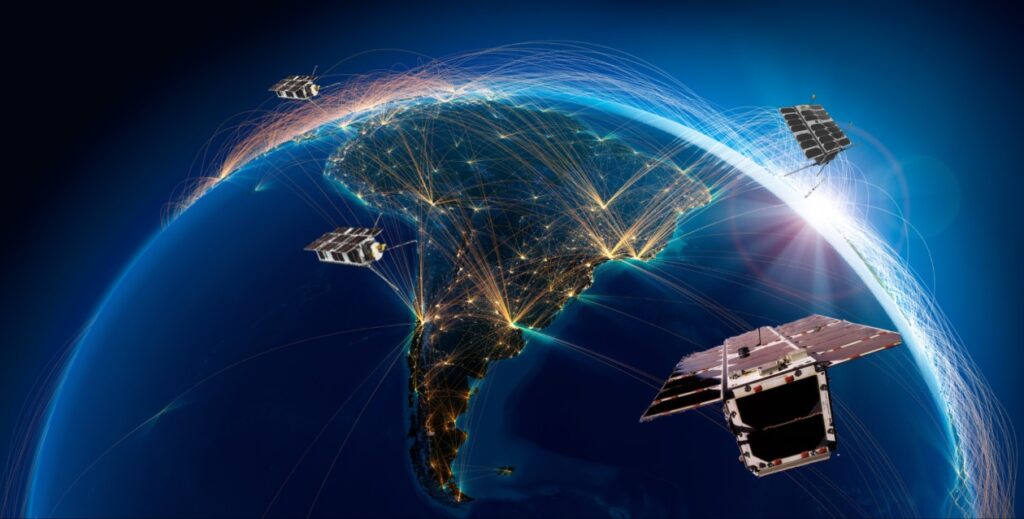As the Internet of Things (IoT) continues to transform industries worldwide, connectivity remains the backbone of its success. While traditional cellular networks provide robust coverage in urban areas, vast rural and remote regions still remain underserved. This is where the convergence of LoRaWAN and satellite connectivity is revolutionising IoT by delivering reliable, low-cost, and scalable communication solutions across the globe.
The Internet of Things (IoT) refers to a network of interconnected physical objects, devices, or “things” that are embedded with sensors, software, and other technologies to collect and exchange data over the internet. These “things” can range from everyday household items to industrial machinery, medical devices, agricultural machinery, vehicles and containers. The ultimate goal of IoT is to create smarter, more efficient, and responsive systems by leveraging data and interconnectivity.

What is LoRaWAN?
The LoRa Alliance, a leading organization behind the development and standardisation of LoRaWAN, recognises satellite IoT as a critical enabler for extending the network’s global reach and enhancing its applicability in remote and underserved areas.
LoRaWAN (Long Range Wide Area Network) is a low-power, long-range wireless protocol designed specifically for IoT devices. It operates in unlicensed radio spectrum bands and excels at transmitting small amounts of data over significant distances while consuming minimal power. These attributes make LoRaWAN ideal for devices like sensors, meters, and trackers that need to function for years on a single battery.
LoRaWAN is part of the broader category of Low Power Wide Area Networks (LPWANs), which also includes other technologies like Sigfox, NB-IoT (Narrowband IoT), Mioty and LTE-M. LPWANs are designed for long-range communication at low data rates, making them perfect for IoT use cases that prioritize power efficiency and extended range.
However, while LoRaWAN is excellent for localized IoT networks, its coverage is typically limited to the availability of terrestrial gateways. For use cases in remote or hard-to-reach areas, expanding coverage beyond terrestrial constraints is crucial. That’s where satellite connectivity comes in.
The Role of Satellite in IoT Connectivity
Satellites provide the ultimate solution for IoT coverage gaps. Unlike terrestrial networks, satellites have a global footprint, capable of connecting devices anywhere on the planet – from open oceans to mountain ranges to dense rainforests. Modern satellite constellations, including Low Earth Orbit (LEO) systems, offer low-latency, high-reliability communications, making them an essential component of IoT infrastructure.
By integrating satellite networks with IoT protocols like LoRaWAN, it becomes possible to create a seamless, hybrid communication system that enables IoT deployments at scale.
Why Combine LoRaWAN and Satellite?
The integration of LoRaWAN with satellite connectivity enables IoT on a massive global scale. Here’s why:
Global Coverage
Satellite-enabled LoRaWAN networks extend IoT coverage to even the most remote corners of the earth. Whether it’s monitoring environmental conditions in the Arctic or tracking assets in the middle of the Pacific Ocean, this hybrid solution ensures that no location is out of reach.
Cost Efficiency
Traditional satellite communication can be expensive for IoT applications due to the high costs of hardware and spectrum licensing. However, LoRaWAN’s low data rates and efficient transmission minimise bandwidth usage, making satellite connectivity far more cost-effective.
Low Power Consumption
IoT devices often need to operate for years without direct access to power sources. LoRaWAN’s low-power design, combined with efficient satellite communication protocols, ensures extended battery life, even for devices in remote locations.
Scalability
The integration of satellite and LoRaWAN enables massive scalability for IoT networks. Thousands of sensors can be deployed and managed without requiring complex infrastructure on the ground.
Real-World Applications
The synergy between terrestrial LoRaWAN networks and satellite connectivity unlocks new possibilities for IoT across multiple industries:
- Agriculture: Monitor soil moisture, tank level monitoring, crop health, weather stations and livestock movement in remote farming areas with no cellular coverage.
- Maritime: Track fishing vessels, buoys, and cargo across oceans, ensuring regulatory compliance and operational efficiency.
- Environmental Monitoring: Collect data on weather, pollution, ecosystems, pollinators, forests and wildlife in hard-to-reach ecosystems.
- Logistics and Asset Tracking: Provide end-to-end visibility for supply chains, even in regions without terrestrial network coverage.
Challenges and Innovations
While the combination of LoRaWAN and satellite presents exciting opportunities, it also comes with challenges. For example:
- Latency: Although modern satellite systems minimize latency, it’s still higher than terrestrial networks. Use cases must account for this.
- Bandwidth Limitations: Satellites have finite bandwidth, requiring efficient data protocols and compression.
- Cost Barriers: While LoRaWAN reduces costs, satellite connectivity integration and data costs are a factor to be considered in return on investment models. Innovations in satellite technology, such as nanosatellites, are helping lower these costs.
The Future of IoT Connectivity
The integration of LoRaWAN and satellite connectivity is a key new innovation of IoT. As satellite networks become more advanced and accessible, this hybrid approach will redefine what’s possible for industries that rely on IoT. By eliminating coverage limitations and enabling affordable, low-power communication, LoRaWAN and satellite are paving the way for a truly connected planet. As more and more LEO satellites are launched each year the availability of services is increasing, data rates are increasing and latency is decreasing.
Whether you’re managing agricultural operations, tracking critical assets, or monitoring the environment, this powerful combination ensures that connectivity is no longer a limitation for your IoT ambitions.
Are you ready to unlock the potential of LoRaWAN and satellite for your IoT needs?